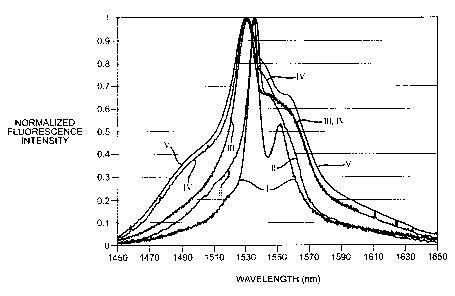Une partie des informations de ce site Web a été fournie par des sources externes. Le gouvernement du Canada n'assume aucune responsabilité concernant la précision, l'actualité ou la fiabilité des informations fournies par les sources externes. Les utilisateurs qui désirent employer cette information devraient consulter directement la source des informations. Le contenu fourni par les sources externes n'est pas assujetti aux exigences sur les langues officielles, la protection des renseignements personnels et l'accessibilité.
L'apparition de différences dans le texte et l'image des Revendications et de l'Abrégé dépend du moment auquel le document est publié. Les textes des Revendications et de l'Abrégé sont affichés :
| (12) Demande de brevet: | (11) CA 2367253 |
|---|---|
| (54) Titre français: | VERRES AU SILICATE A DEPOT PAR PLASMA EN SURFACE |
| (54) Titre anglais: | SPCVD SILICATE GLASSES |
| Statut: | Réputée abandonnée et au-delà du délai pour le rétablissement - en attente de la réponse à l’avis de communication rejetée |
| (51) Classification internationale des brevets (CIB): |
|
|---|---|
| (72) Inventeurs : |
|
| (73) Titulaires : |
|
| (71) Demandeurs : |
|
| (74) Agent: | GOWLING WLG (CANADA) LLP |
| (74) Co-agent: | |
| (45) Délivré: | |
| (86) Date de dépôt PCT: | 2000-02-11 |
| (87) Mise à la disponibilité du public: | 2000-09-21 |
| Licence disponible: | S.O. |
| Cédé au domaine public: | S.O. |
| (25) Langue des documents déposés: | Anglais |
| Traité de coopération en matière de brevets (PCT): | Oui |
|---|---|
| (86) Numéro de la demande PCT: | PCT/US2000/003602 |
| (87) Numéro de publication internationale PCT: | WO 2000055101 |
| (85) Entrée nationale: | 2001-09-05 |
| (30) Données de priorité de la demande: | ||||||
|---|---|---|---|---|---|---|
|
Les verres de l'invention contiennent une combinaison de F et Al¿2?O¿3? pour obtenir une fluorescence encore plus large et une meilleure planéité du gain. De plus le dépôt par plasma en surface (SPCVD) comprend de grandes quantités de N dans une fibre à faible perte dont la charge élevée a un impact sur le comportement des terres rares. Le dépôt par plasma en surface (SPCVD) produit des préformes de fibres aux niveaux élevés de F, Al¿2?O¿3? et N. Ces verres fortement fluorés produisent une émission Er?3+¿ beaucoup plus large que la silice de type I ou type II pour des amplificateurs multicanaux perfectionnés. Le SPCVD fluore avec succès la silice avec des pertes inférieures à 5 dB/km et une largeur d'émission Er?3+¿ accrue.
These glasses incorporate a combination of F and Al2O3 to achieve even wider
fluorescence and improved gain flatness. In addition, SPCVD incorporates large
amounts of N into low-loss fiber whose high charge has an impact on rare earth
behavior. The Surface Plasma Chemical Vapor Deposition (SPCVD) produces fiber
preforms with high levels of F, Al2O3, and N. These heavily fluorinated
glasses provide much broader Er3+ emission than Type I or Type II silica for
enhanced multichannel amplifiers. SPCVD successfully fluorinates silica with
losses below 5 dB/km and increased Er3+ emission width.
Note : Les revendications sont présentées dans la langue officielle dans laquelle elles ont été soumises.
Note : Les descriptions sont présentées dans la langue officielle dans laquelle elles ont été soumises.

2024-08-01 : Dans le cadre de la transition vers les Brevets de nouvelle génération (BNG), la base de données sur les brevets canadiens (BDBC) contient désormais un Historique d'événement plus détaillé, qui reproduit le Journal des événements de notre nouvelle solution interne.
Veuillez noter que les événements débutant par « Inactive : » se réfèrent à des événements qui ne sont plus utilisés dans notre nouvelle solution interne.
Pour une meilleure compréhension de l'état de la demande ou brevet qui figure sur cette page, la rubrique Mise en garde , et les descriptions de Brevet , Historique d'événement , Taxes périodiques et Historique des paiements devraient être consultées.
| Description | Date |
|---|---|
| Inactive : CIB de MCD | 2006-03-12 |
| Inactive : CIB de MCD | 2006-03-12 |
| Inactive : CIB de MCD | 2006-03-12 |
| Inactive : CIB de MCD | 2006-03-12 |
| Inactive : CIB de MCD | 2006-03-12 |
| Inactive : CIB de MCD | 2006-03-12 |
| Le délai pour l'annulation est expiré | 2005-02-11 |
| Demande non rétablie avant l'échéance | 2005-02-11 |
| Réputée abandonnée - omission de répondre à un avis sur les taxes pour le maintien en état | 2004-02-11 |
| Lettre envoyée | 2002-08-23 |
| Inactive : Transfert individuel | 2002-07-02 |
| Inactive : Page couverture publiée | 2002-02-22 |
| Inactive : Lettre de courtoisie - Preuve | 2002-02-19 |
| Inactive : Notice - Entrée phase nat. - Pas de RE | 2002-02-18 |
| Demande reçue - PCT | 2002-02-07 |
| Demande publiée (accessible au public) | 2000-09-21 |
| Date d'abandonnement | Raison | Date de rétablissement |
|---|---|---|
| 2004-02-11 |
Le dernier paiement a été reçu le 2003-01-16
Avis : Si le paiement en totalité n'a pas été reçu au plus tard à la date indiquée, une taxe supplémentaire peut être imposée, soit une des taxes suivantes :
Veuillez vous référer à la page web des taxes sur les brevets de l'OPIC pour voir tous les montants actuels des taxes.
| Type de taxes | Anniversaire | Échéance | Date payée |
|---|---|---|---|
| Taxe nationale de base - générale | 2001-09-05 | ||
| Enregistrement d'un document | 2001-09-05 | ||
| TM (demande, 2e anniv.) - générale | 02 | 2002-02-11 | 2002-01-14 |
| TM (demande, 3e anniv.) - générale | 03 | 2003-02-11 | 2003-01-16 |
Les titulaires actuels et antérieures au dossier sont affichés en ordre alphabétique.
| Titulaires actuels au dossier |
|---|
| CORNING INCORPORATED |
| Titulaires antérieures au dossier |
|---|
| MATTHEW J. DEJNEKA |
| ROSTISLAV KHRAPKO |